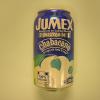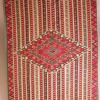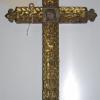Mexico
|
1950s
This pair of men's black alligator oxfords lace up with cordded shoe ties. The inner sole is beige and is stamped in "gold" in both shoes "Sam's Shoe Store" (which is... |
1906
This is a 1906 Mexican 5 centavos piece. The eagle and snake on one side "Estados Unidos Mexicanos;" on the other side 1 c. |
|
1881
This 1881 coin is a Mexican 25 centavos piece. On one side is the Mexican eagle and snake "Republica Mexicaca, 1881." On the other side is a cap, scales and a sword, "25 Centavos M_M 9027." |
1906
This coin is a Mexican 20 centavos piece, dating 1906. On one side is the emblem of Mexico, the eagle and the snake, "Estados Unidos Mexicanos." On the other side, 20 Centavos. |
|
2008
Empty aluminum can that contained "Nectar de Chabacano" ("Apricot Nectar"), made by the brand Jumex. Can shows a logo for the brand and an illustration of apricots and a small tree. Nutritional... |
c.1860
This Saltillo sarape is of fine quality. It can be described as a Classic Saltillo Sarape: the center is composed of a concentric diamond; the field is a vertical mosaic; and the border is a... |
|
18th C.
The intersection of the cross has a depiction of the face of Jesus, crowned with thorns, probably representing the image on Veronica's veil. From the History Information Station: ... |
1910-1930
Serape. Description: Serape, wool with cotton, and cotton fringe. Mexico 19th century. Many colors, commercial dyes. Green rose, red, yellow, blues, lavendars, white. History: the Serape belonged... |
|
18th c.
Crosses. Description: 1 of 5; different sizes, wooden, from all over Mexico; all have wooden plaques with "INRI" which are attached to top of cross a. 8' long; 5' 7 3/8" crosspiece; 2 3/4... |
18th c.
Crosses. Description: 1 of 5; different sizes, wooden, from all over Mexico; all have wooden plaques with "INRI" which are attached to top of cross a. 8' long; 5' 7 3/8" crosspiece; 2 3/4... |
|
18th c.
Cross. Description: iron. Wrought and chiseled iron with fretwork. The cross is flat and it is attached to a brass globe that has sleeve fitted for a pole. At the base of the cross there... |
18th Century|17th Century
Painting. (Cataloguing changed on 9/28/04 by S. Macarron) Archangel Saint Raphael. He is depicted with his classic attributes: a pilgrim's staff and gourd and he is holding a fish. Saint... |
|
c.1970
Anne Bernstein added military uniform buttons from her father to the cuffs of this Mexican dress. The dress is long, to the floor, the sleeves are long and the neckline is a deep scoop. Both the... |
1960s
A: Jacket, blue wool, decorated with a meandering design of white rayon soutache braid, machine stitched in place, on the shawl collar, down the front edge, around the hem, at 4 pockets (two on... |
|
1960s
A: Jacket, cut short (to the waist like a charro jacket) of tan wool. Appliqued in gold colored felt in an intricate design on the collar, down the front edges, around the hem, two breast... |
c. 1955-1965
This red blouse, which was probably worn with the China Poblana skirt 2008.12.10, has a red velvet yoke that almost comes to a "V" in the front. The blouse has short sleeves. The yoke... |
|
c. 1955-1965
This white rayon satin blouse has a white velvet yoke. The sleeves are short and the neckline is scooped. The yoke is rounded to fit the scooped neckline, and is decorated with multi-colored... |
c. 1955-1965
China Poblana skirt of white rayon velvet, with a zig-zag hem done in red, white and green satin. The yoke is zig-zag of red, white and green satin. TYhe skirt is elaborately decorated with... |
|
c.1955-1965
THis red velvet China Poblana skirt is elaborately decorated with sequins fforming catus, Aztec figures, flowers and the Mexican Eagle and serpent. It has a zig-zag yoke (just below the... |

















